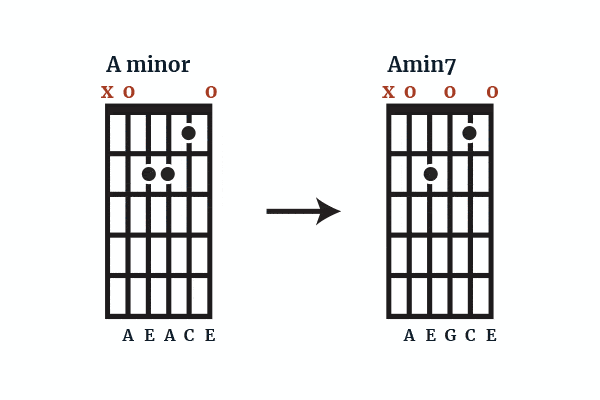Well howdy there. If you are new to guitar and have heard the term ‘cowboy chords’ thrown around, you might be wondering what this actually means?
In the following short article, I’m going to explain exactly what cowboy chords are and how using basic guitar theory we can construct them, where the term (probably) has come from, and provide some useful suggestions on how to improve them.
Cowboy chords are open chords. This means they are chords that include open strings (notes you don’t need to fret) and are played in the open, or first position, meaning within the first three frets.
They are also triads e.g. chords that contain three notes and usually only require the index, middle, and pointer fingers of the fretting hand to play.
Cowboy chords are often the first chords guitarists will learn and include:
| E Major | E minor |
![Cowboy Chords [The Complete Guide] 2 E Major Chord Diagram](https://theacousticguitarist.com/wp-content/uploads/2021/05/e-major-chord.gif) | ![Cowboy Chords [The Complete Guide] 3 E minor Chord Diagram](https://theacousticguitarist.com/wp-content/uploads/2021/05/e-minor-chord-chart.gif) |
| A Major | A minor |
![Cowboy Chords [The Complete Guide] 4 A Major Chord Chart](https://theacousticguitarist.com/wp-content/uploads/2021/05/a-major-chord-chart.gif) | ![Cowboy Chords [The Complete Guide] 5 A minor Chord Chart](https://theacousticguitarist.com/wp-content/uploads/2021/05/a-minor-chord-chart.gif) |
| D Major | D minor |
![Cowboy Chords [The Complete Guide] 6 D Major Chord Chart](https://theacousticguitarist.com/wp-content/uploads/2021/05/d-major-chord-chart.gif) | ![Cowboy Chords [The Complete Guide] 7 D minor Chord Chart](https://theacousticguitarist.com/wp-content/uploads/2021/05/d-minor-chord-chart.gif) |
| G Major | C Major |
![Cowboy Chords [The Complete Guide] 8 G Major Chord Chart](https://theacousticguitarist.com/wp-content/uploads/2021/05/g-major-chord-chart.gif) | ![Cowboy Chords [The Complete Guide] 9 C Major Chord Chart](https://theacousticguitarist.com/wp-content/uploads/2021/05/c-major-chord-chart.gif) |
Cowboy chords are amongst the easiest chords to learn on guitar, only requiring the index, middle, and ring fingers of the fretting hand to play. But, don’t let that fool you, cowboy chords ‘aint just for tenderfoots‘, they are also the most useful chords a beginner will learn, providing a great starting point on the guitar that will enable the beginner guitarist to play a vast number of songs, developing their timing and sense of rhythm along the way.
Why Are They Called Cowboy Chords?
The term cowboy, aside from when used to describe those who tend cattle, is commonly used to describe someone who lacks skills in a particular trade or has a tendency to be reckless.
It’s not difficult to imagine those with extensive knowledge of advanced chord theory e.g. the jazz guitar community or more experienced musicians might use the term in a derogatory way.
The reason for this is simple, cowboy chords are often used as substitutes for more complex chord voicings, making what would otherwise be a more challenging song to learn on guitar, more accessible.
While that’s one theory, it’s also true that a vast number of campfire and early western songs (the precursor to country music) are three-chord songs (I-IV-V) played solely with open position aka cowboy chords. This was typified by Western movie stars of the 1940s, none more so than the singing cowboy Gene Autry.
There’s a joke that if you see a guitar that has far more wear and tear on the first three to five frets you can bet there’s a buckle rash on the back of the guitar as well 🙂 In truth, almost all guitars tend to show more wear and tear on these frets but you get the point.
It’s important to keep in mind, this doesn’t mean the songwriters of this period lacked creativity. Cowboy chords were likely used so extensively more out of necessity as guitars of this period were often 14-fret guitars, with no truss rod, and played with catgut strings.
As a result, they were far more difficult to play, making more complex chord shapes difficult. Anyone who has noted the difference between playing barre chords on electric guitar V modern acoustic guitar will understand.
Improve Your Messy Cowboy Chords
One of the most effective tips I’ve been shown over the years to help tidy up cowboy chords (although this could apply to any chords really) is to work back and forth between strumming and playing arpeggios e.g. picking each note of the chord instead of strumming.
You will soon hear the problem notes when picked individually. In most cases, the note will be muted or partly muted and unable to ring out cleanly.
For example, If you are learning to play the C Major chord in the open position (the struggle is real for those with small hands) playing the chord cleanly is likely to be challenging. The biggest hindrance is the note on the B string (C).
String tension is highest closest to the nut and as this note lives on the first fret beginners can struggle with the required finger strength. This can result in an otherwise messy-sounding chord and subsequently going through life avoiding learning how to play songs with C major.
You can improve your cowboy chords by focusing on the following:
- Pressing more firmly on the strings (find the right balance, pressing too firmly can also cause problems)
- Using the tips of your fingers (Avoid using the fleshy fat part of the fingers)
- Bending your fingers at the knuckles more
- Placing your fingers closer to the fret (but not on the fret wire)
Summary
Cowboy chords, aka open position or first position chords, are chords we all learn on guitar, but unlike the training wheels on your first bike, they will always come in handy, as they are used extensively in all forms of music.
So, rather than considering them for beginners only, find ways to spice up your cowboy chords by incorporating dynamics to emphasize specific parts of songs and incorporating techniques such as hammer-ons and pull-offs to make them more interesting once you are past the beginner phase.
![Cowboy Chords [The Complete Guide] 1 Cowboy Chords](https://theacousticguitarist.com/wp-content/uploads/2021/05/cowboy-chords.jpg)

![7th Chords [Complete Guide] 11 What are 7th Chords](https://theacousticguitarist.com/wp-content/uploads/2021/09/what-are-7th-chords.gif)
